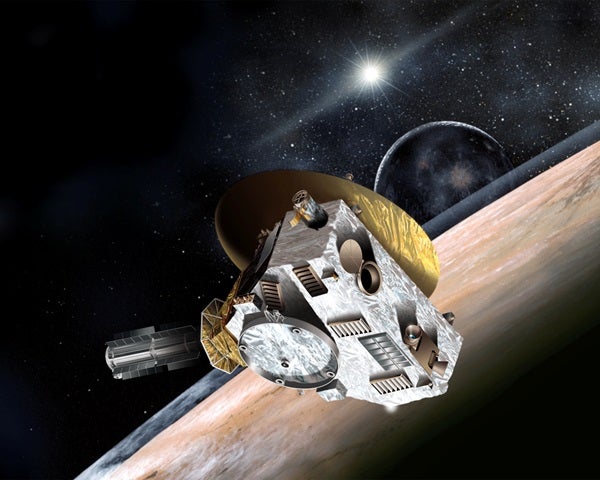Exactly 50 years ago today, NASA’s Mariner 4 mission performed the first Mars flyby and took the first close-up images of another planet. And precisely two decades ago, the first mission to orbit Jupiter, the Galileo spacecraft, arrived at the largest planet (Tragically, Claudia Alexander, Galileo’s final project manager, died this weekend.) It’s also the anniversary of Apollo-Soyuz.
In the space of one generation, NASA engineers have now officially visited each of the nine major worlds in our solar system and wrapped up the first era of exploration.
But Alan Stern says mission managers didn’t choose the date for the sake of symbolism or he would have pushed for July 4.
“We did not choose the day for this reason; it was chosen for things like orbital mechanics and wanting to image the night side of the planet,” Stern said in a recent interview with Astronomy. “We looked at dates from December of 2014 to the end of July 2015, and ultimately we got it down to a two-week period and the 14th came out on top.
Mission planners settled on their exact timing over the course of several months in the summer of 2008. To catch the night side of Pluto in Charon’s light, New Horizons, 9.5-year-long mission had to arrive with a geometry precise to within 100 seconds. And such an opportunity only comes along every 3.2 days. So Stern says there were about 10 such opportunities this month, but half would have Charon in front of Pluto — the opposite of what the team wanted. The exact locations of Pluto’s moons Nix and Hydra were also crucial. New Horizons is extremely vulnerable to debris.
Their concern for hitting something during the flyby grew as more and more satellites of Pluto were discovered.
“Although the odds of hitting a satellite you don’t now about are very small, the small satellites have very little gravity,” Stern says. That means if there’s been a recent collision, there could be tiny pieces still floating in the area that would be impossible to see on approach.
“Even rice-sized grains are lethal to New Horizons,” he says. The team planned emergency safe haven routes just in case something came up.
Fortunately, they didn’t have to use them. The team now thinks the chances of hitting something are minimal. Dust distribution models made with Hubble, lab analysis done with high-velocity guns, and New Horizons’ own observations have given Stern and other scientists comfort.
But the combined effort all led New Horizons to today, a neat half-century from Mariner 4’s flyby at Mars.
NASA says it plans a celebration of the 50-year milestone with some of the scientists to discuss what it’s like to witness all the planets visited in one human lifespan.
And, in a recent interview with Astronomy, James Green, director of NASA’s Planetary Science Division, said the date could also be thought of as the start of the next great era of planetary exploration. NASA likes to do exploration in phases — first flybys, then orbiters, and finally rovers.
“We have terrestrial planets, gas giants, and Kuiper Belt objects, and this is our first reconnaissance of that region,” Green says. “New Horizons will complete our initial reconnaissance of the solar system, and the next step is continuing on that exploration. Historically, it will be a huge step for us to take.”
Eric Betz is an associate editor of Astronomy. He’s on Twitter: @ericbetz.










